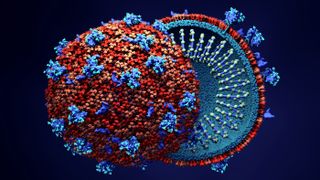COVID-19 Spike-Host Cell Receptor GRP78 Binding Site Prediction
Affiliations
- PMID: 32169481
- PMCID: PMC7102553
- DOI: 10.1016/j.jinf.2020.02.026
Abstract
Objectives: Understanding the novel coronavirus (COVID-19) mode of host cell recognition may help to fight the disease and save lives. The spike protein of coronaviruses is the main driving force for host cell recognition.
Methods: In this study, the COVID-19 spike binding site to the cell-surface receptor (Glucose Regulated Protein 78 (GRP78)) is predicted using combined molecular modeling docking and structural bioinformatics. The COVID-19 spike protein is modeled using its counterpart, the SARS spike.
Results: Sequence and structural alignments show that four regions, in addition to its cyclic nature have sequence and physicochemical similarities to the cyclic Pep42. Protein-protein docking was performed to test the four regions of the spike that fit tightly in the GRP78 Substrate Binding Domain β (SBDβ). The docking pose revealed the involvement of the SBDβ of GRP78 and the receptor-binding domain of the coronavirus spike protein in recognition of the host cell receptor.
Conclusions: We reveal that the binding is more favorable between regions III (C391-C525) and IV (C480-C488) of the spike protein model and GRP78. Region IV is the main driving force for GRP78 binding with the predicted binding affinity of -9.8 kcal/mol. These nine residues can be used to develop therapeutics specific against COVID-19.
Keywords: BiP; COVID-19 spike; GRP78; Pep42; Protein-protein docking; Structural bioinformatics.
Copyright © 2020. Published by Elsevier Ltd.
Conflict of interest statement
Declaration of Competing Interests All of the authors declare that there is no competing interest in this work.
Similar articles
- Emerging WuHan (COVID-19) coronavirus: glycan shield and structure prediction of spike glycoprotein and its interaction with human CD26.Emerg Microbes Infect. 2020 Mar 17;9(1):601-604. doi: 10.1080/22221751.2020.1739565. eCollection 2020.PMID: 32178593 Free PMC article.
- Molecular Mechanism of Evolution and Human Infection with SARS-CoV-2.Viruses. 2020 Apr 10;12(4):E428. doi: 10.3390/v12040428.PMID: 32290077
- Spike protein recognition of mammalian ACE2 predicts the host range and an optimized ACE2 for SARS-CoV-2 infection.Biochem Biophys Res Commun. 2020 May 21;526(1):165-169. doi: 10.1016/j.bbrc.2020.03.047. Epub 2020 Mar 19.PMID: 32201080 Free PMC article.
- Perspectives on monoclonal antibody therapy as potential therapeutic intervention for Coronavirus disease-19 (COVID-19).Asian Pac J Allergy Immunol. 2020 Mar;38(1):10-18. doi: 10.12932/AP-200220-0773.PMID: 32134278 Review.
- [Spike protein in the detection and treatment of novel coronavirus].Sheng Wu Yi Xue Gong Cheng Xue Za Zhi. 2020 Apr 25;37(2):246-250. doi: 10.7507/1001-5515.202002050.PMID: 32329276 Review. Chinese.
Cited by 3 articles
- Novel guanosine derivatives against MERS CoV polymerase: An in silico perspective.J Biomol Struct Dyn. 2020 Apr 27:1-9. doi: 10.1080/07391102.2020.1758789. Online ahead of print.PMID: 32306854 Free PMC article.
- Are patients with inflammatory bowel disease at increased risk for Covid-19 infection?J Crohns Colitis. 2020 Mar 26:jjaa061. doi: 10.1093/ecco-jcc/jjaa061. Online ahead of print.PMID: 32215548 Free PMC article.
- Anti-HCV, nucleotide inhibitors, repurposing against COVID-19.Life Sci. 2020 May 1;248:117477. doi: 10.1016/j.lfs.2020.117477. Epub 2020 Feb 28.PMID: 32119961 Free PMC article.
References
- Organization WH. World Health Organization; 2020. Surveillance case definitions for human infection with novel coronavirus ( nCoV): interim guidance v1, January 2020.
- Organization WH . World Health Organization; 2020. Laboratory testing of human suspected cases of novel coronavirus ( nCoV) infection: interim guidance, 10 January 2020.
- Organization WH . World Health Organization; 2020. Infection prevention and control during health care when novel coronavirus ( nCoV) infection is suspected: interim guidance, January 2020.
MeSH terms
Substances
Supplementary concepts
LinkOut - more resources
Full Text Sources
Medical
Miscellaneous






